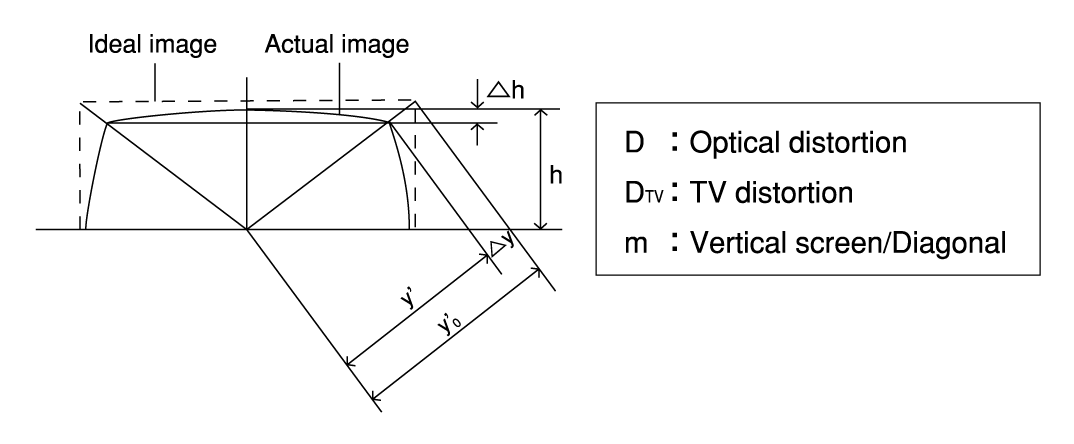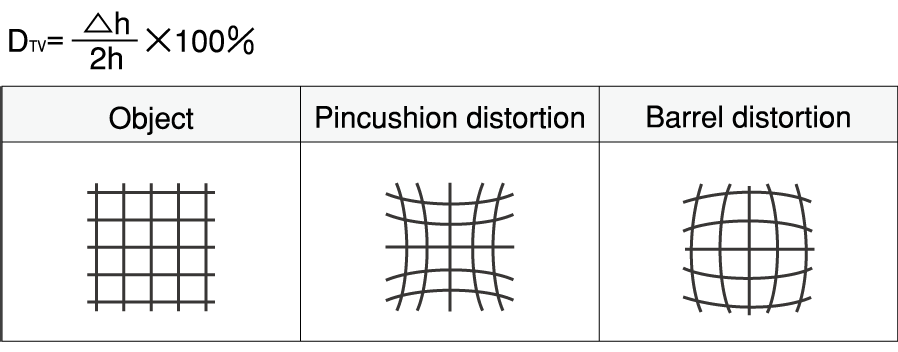
Resolution indicates the ability to recognize two points that are close together. Resolution values in this catalogue are theoretical resolution at 550nm. Resolution = 0.61 x λ/ NA
Resolving power indicates the number of black and white lines distinguished within 1mm in an image through a black and white grid-like chart lens. It is expressed by line/mm.
For example, 100 line/mm means that black and white pitch 1/100mm(10 μ ) can be distinguished. The width of both the black and white lines is 1/200mm( 5μ).
The total number of black and white horizontal stripes on a TV monitor screen. It is expressed in TV lines. For resolving power, a pair of black and white lines is counted as one line. However, for TV lines, one pair is counted as 2 TV lines.
For example, if 470 horizontal TV lines of 1/2 CCD (H = 6.4mm) is used, required resolving power is 1mm/(6.4mm/(470/2)) = 36.72/mm.
Aperture efficiency indicates the brightness difference between the optical axis of the image formation plane and its surrounding area when an evenly bright object is captured with a lens. It is expressed by percent(%) assuming that the center brightness is 100. It is one of a lens’s optical characteristics.

Optical distortion
Lens’s aberration where a straight object outside of the
optical axis appears curved.

TV distortion
Image distortion on a TV monitor. The closer to zero, the
better the performance.

Shading is the brightness difference between TV monitor’s center and its edges when an evenly bright object is captured with a lens. Shading indicates comprehensive performance of a lens and TV camera.
In lenses’ optional systems, positions where images are formed and image magnification differ according to light’s wavelength. Rays with different wavelengths have different colors. This is called chromatic aberration. Aberration on the optical axis is called chromatic aberration on the axis and magnification difference is called magnification chromatic aberration.
The brightness of a lens at infinity. It is calculated by dividing the focal length by the diameter of entrance pupil (D) ( effective aperture)). F No. = f/D
The brightness of a lens at a certain magnification. Effective F No. = (1 + M) x F No.
The higher the NA, the greater the resolution and brightness are. When the half angle that an image makes on exit pupil is u’ and refractive index is n’, n’ xsin u’ is called image side numberical aperture, NA’. NA in this catalogue indicates object side numerical aperture.

NA=M/2xF, NA’=1/2xF. Relation of NA and NA’ is NA=NA’ x Optical magnfification or NA’=NA/optical magnficiattion.
It provides a graph analyzing a lens’ ability to resolve sharp details in very fine sets of parallel lines, and a lens’ contrast or ability to provide a sharp transfer between light and dark areas in sets of thicker parallel lines.
Depth is the distance between the nearest and farthest points that appear in acceptably sharp forcus when a CCD is shifted back and force from the best focal point. Depth range of the image side is called depth of focus.
The angle formed by imaginary lines connecting the lens second principal point with both ends of the image diagonal. Angle of view is directly associated with lens focal length. As the focal length is longer, the angle of view is narrower. Angle of view = 2xtan -1D(Image size)/ 2 f(Focal length)
Images through lenses theoretically form as points. Acceptable blur on an acceptably clear image is called the permissible circle of confusion.Depth is the distance between the nearest and farthest points that appear in acceptably sharp focus when an object is shifted back and force from the best focal point. Depth range of the object side is called depth of field. Depth of field = 2(Permissible circle of confusion x Effective F No/Magnification²)
Distance from the object to the front lens.
Distance from the object to the image sensor.
Focal length is the distance from the optical system’s principle point to the focal point. Distance from the vertex of the last lens to the back focal point is called back length. Distance from the vertex of the first lens to the front focal point is called front focal length.
The diameter of the sharp image circle formed by a lens. Area sensor is expressed by inch, and diameter of image circle is equal to diagonal of sensor. Image circle of diameter for line sensor is equal to the maximum sensor size. It is expressed by pixel size x resolution.